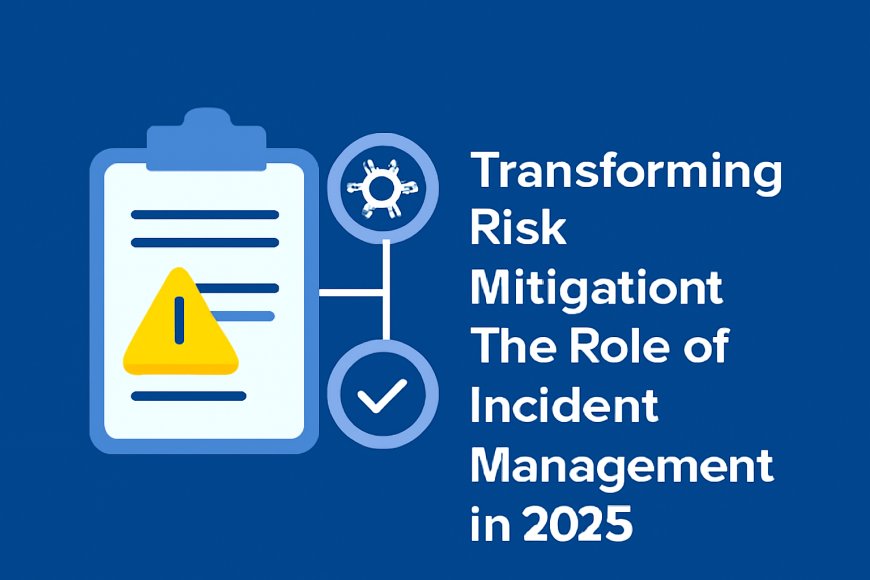Transforming Risk Mitigation: The Role of Incident Management in 2025
Learn how an incident management system boosts quality management and operational efficiency. Discover why incident management is essential in life sciences and manufacturing to stay compliant and resilient in 2025.

Introduction: The Growing Need for Robust Incident Management Systems
In todays competitive and regulated business environment, organizations cannot afford to ignore incident management. Whether it's in life sciences or manufacturing, managing incidents promptly and effectively is no longer a mere operational necessityit's a critical factor in ensuring regulatory compliance, maintaining product quality, and safeguarding employee safety.
An incident management system has emerged as the backbone of effective risk mitigation, facilitating a swift, structured response to incidents while ensuring a systematic, data-driven approach to resolution. In this blog, we explore how modern incident management practices are transforming operations across sectors, from medical device and pharma manufacturing to automotive and aerospace industries. By integrating quality management with an efficient incident management system, businesses can achieve superior compliance, streamline workflows, and create a culture of continuous improvement.
What Is Incident Management and Why Is It Vital in 2025?
Defining Incident Management in a Modern Context
At its core, incident management is the process of identifying, documenting, and addressing incidentswhether they involve safety hazards, equipment failure, regulatory breaches, or quality issues. However, as industries grow more complex and globalized, incident management has evolved into a comprehensive system for real-time monitoring, reporting, root cause analysis, corrective action, and prevention.
In 2025, companies require more than just a reactive approach to incident handling. They need a proactive strategy underpinned by an incident management system that can not only address the immediate risks but also anticipate and mitigate future incidents based on historical data and predictive analytics.
The Business Case for Effective Incident Management
The importance of an efficient incident management system cannot be overstated. Incidentswhether workplace injuries, environmental hazards, or compliance failurescan result in hefty fines, costly downtime, damaged reputations, and legal repercussions. Conversely, when managed properly, incidents offer valuable learning opportunities that improve processes, enhance compliance, and ultimately drive long-term business success.
The Key Elements of an Incident Management System
Seamless Integration with Quality Management
An incident management system, when effectively integrated with quality management practices, ensures that every incident is handled within a structured framework. This integration allows for the identification of root causes, the determination of corrective actions, and the implementation of preventive measures across the organization.
By aligning incident management with quality management principles, companies not only mitigate risks but also continuously improve operational processes, ensuring a consistent, high-quality output that meets or exceeds regulatory standards.
Real-Time Incident Tracking and Reporting
One of the primary functions of an incident management system is the ability to track incidents in real time, from initial detection to resolution. This allows companies to address issues quickly, minimizing their impact. Moreover, detailed reports provide valuable data for audits, future risk assessments, and regulatory compliance documentation, ensuring that companies can demonstrate ongoing adherence to industry standards such as ISO 9001, ISO 13485, and 21 CFR Part 11.
The Role of Incident Management in Life Sciences
Ensuring Compliance with Regulatory Requirements
Life sciences industries, including pharmaceuticals and medical devices, operate under strict regulations that mandate immediate and thorough responses to safety and quality incidents. An incident management system that integrates with quality management tools ensures that each incident is recorded, assessed, and addressed according to industry-specific regulatory guidelines.
Failure to adhere to regulatory requirements can result in costly fines, delays in product approvals, and even product recalls. Therefore, having a robust incident management system in place is not just about risk mitigationit's about ensuring compliance with FDA, EMA, and other regulatory authorities.
Streamlining Clinical Trials and Product Development
In the medical device and pharmaceutical sectors, product development and clinical trials are fraught with potential safety risks and operational incidents. An effective incident management system ensures that any deviations or adverse events are quickly identified and managed, minimizing delays in clinical trials and safeguarding product integrity.
Incident Management and Quality Assurance in Manufacturing
Enhancing Safety Protocols in Complex Manufacturing
In industries like aerospace, automotive, and heavy equipment manufacturing, safety is paramount. These sectors are exposed to numerous operational risks, from equipment malfunctions to supply chain disruptions. An incident management system helps businesses manage these risks by providing real-time insights, assigning corrective actions, and ensuring compliance with safety protocols.
By integrating the system with a quality management approach, manufacturers can also ensure that each incident is investigated thoroughly, enabling them to identify underlying quality issues that may otherwise go unnoticed.
Preventing Downtime and Production Delays
In manufacturing environments, an unaddressed safety incident or equipment failure can lead to significant downtime and production delays. The ability to manage and resolve incidents quickly through a structured incident management system minimizes these disruptions, ensuring a smoother flow of operations and more consistent output.
Scaling Incident Management Across Global Operations
Managing Multi-Site Operations and Cross-Border Compliance
For global organizations, managing incidents across multiple sites, often in different regulatory jurisdictions, can be a logistical challenge. An incident management system helps standardize incident reporting and resolution processes, regardless of location. This consistency ensures compliance with local regulations while maintaining the organization's overall quality standards.
Incident management systems also provide centralized oversight, enabling executives and quality managers to monitor and address incidents across global operations in real time.
Enabling Faster, More Informed Decision-Making
With a centralized incident management system, key stakeholdersincluding VPs, Directors of Quality, and CEOscan access real-time data on incidents from all departments and locations. This transparency allows for faster, more informed decision-making, ensuring that the most critical issues are addressed first and resources are allocated efficiently.
Integrating Incident Management System with Predictive Analytics
Moving Beyond Reactive Management
The integration of predictive analytics with an incident management system helps companies anticipate potential incidents before they occur. By analyzing historical incident data and identifying patterns, businesses can predict areas of high risk and implement preventive measures, reducing the likelihood of incidents in the future.
Predictive capabilities also allow organizations to prioritize risks based on their potential impact, enabling more effective resource allocation and proactive decision-making.
Supporting Continuous Improvement and Risk Reduction
When an incident management system is coupled with predictive analytics, it becomes a tool for continuous improvement. Each incident is an opportunity to improve processes, minimize risk, and enhance quality management practices. By tracking trends, analyzing root causes, and implementing corrective actions, organizations can continually refine their safety protocols and operational workflows.
How Incident Management Systems Strengthen Business Continuity
Ensuring Operational Resilience
An effective incident management system is integral to a companys business continuity plan. By enabling swift identification, reporting, and resolution of incidents, these systems help businesses recover quickly from unexpected disruptions, minimizing downtime and financial loss.
In industries where safety incidents can lead to significant financial and reputational damage, the ability to manage incidents effectively is key to maintaining operational resilience and business continuity.
Facilitating Crisis Management
During major safety events or compliance breaches, a well-integrated incident management system ensures that all parties are notified immediately, and that response procedures are followed swiftly. From crisis management teams to regulatory authorities, incident management systems ensure that all necessary actions are taken in a timely and organized manner.
Conclusion: Why ComplianceQuest is Essential for Business in 2025
As organizations navigate increasingly complex regulatory landscapes, evolving compliance requirements, and heightened customer expectations, they need more than just a reactive approach to risk management. ComplianceQuest provides an integrated solution that combines incident management, quality management, and predictive analytics into a seamless, enterprise-wide platform.
With ComplianceQuest, businesses can ensure that every incident is addressed systematically, that corrective actions are tracked and implemented, and that compliance standards are met consistently. This integrated approach enhances operational efficiency, mitigates risk, and fosters a culture of continuous improvementensuring businesses are prepared for whatever 2025 and beyond may bring.
































